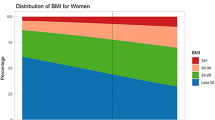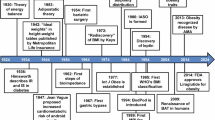Abstract
The recognition of obesity as a disease was in theory established in 1948 by WHO's (World Health Organization) taking on the International Classification of Diseases but the early highlighting of the potential public health problem in the United States and the United Kingdom 35 years ago was considered irrelevant elsewhere. The medical profession disregarded obesity as important despite the new evidence and WHO data set out in the 1980s. Only in 1995 did WHO find greater problems of overweight than underweight in many developing countries but it required the first special obesity consultation in 1997 and particularly the Millennium burden of disease analyses to suddenly highlight its crucial role in the current unmanageable and escalating medical costs globally. Governments now recognize the overwhelming industrial developments that guarantee an escalating epidemic but neither they nor WHO know how to engage in changing the societal framework to promote routine spontaneous physical activity and a transformation of the food system so that low energy-density food of high nutrient quality becomes the norm.
This is a preview of subscription content, access via your institution
Access options
Subscribe to this journal
Receive 12 print issues and online access
$259.00 per year
only $21.58 per issue
Buy this article
- Purchase on SpringerLink
- Instant access to full article PDF
Prices may be subject to local taxes which are calculated during checkout
Similar content being viewed by others
References
Keys A . Seven Countries. A Multivariate Analysis of Death and Coronary Heart Disease. Harvard University Press: Cambridge, MA, US, 1980.
Shaper AG . Cardiovascular disease in the Tropics III, blood pressure and hypertension. BMJ 1972; 3: 805–807.
Norum KR, Johansson L, Botten G, Bjorneboe G-E, Oshaug A . Nutrition and food policy in Norway: effects on reduction of coronary heart disease. Nutr Rev 1997; 55: S32–S39.
Tunstall-Pedoe H (ed). MONICA. Monograph and Multimedia Source Book. The World's Largest Study of Heart Disease, Stroke, Risk Factors and Population Trends (1979–2002). WHO: Geneva, 2003.
Bray GA . Obesity in perspective, Fogarty International Center Series on Preventive Medicine. DHEW publication 75-708. Government Printing Office: Washington, DC, 1973.
James WPT . Department of Health and Social Security and Medical Research Council group. Research on Obesity. A report of the DHSS/MRC group. Her Majesty's Stationary Office: London, 1976.
Obesity: A report of the Royal College of Physicians. J R Coll Physicians Lond 1983; 17: 4–58.
James WPT, Shetty PS . Metabolic adaptation and energy requirements in developing countries. Hum Nutr Clin Nutr 1982; 36: 331–336.
Schofield WN, Schofield C, James WPT . Basal metabolic rate—review and prediction, together with an annotated bibliography of source material. Hum Nutr Clin Nutr 1985; 39: 1–96.
James WPT, Schofield EC . Human Energy Requirements: A Manual for Planners and Nutritionists. Food and Agriculture Organization of the United Nations, Oxford University Press: Oxford, UK, 1990.
Energy and protein requirements. Report of a joint FAO/WHO/UNU Expert Consultation. World Health Organ Tech Rep Ser 724. World Health Organization: Geneva, 1985.
World Health Organization. Prevention of coronary heart disease: report of a WHO expert committee. World Health Organ Tech Rep Ser 678. World Health Organization: Geneva, 1982.
James WPT, Ferro-Luzzi A, Isaksson B, Szostak WB (eds.) Healthy Nutrition: Preventing Nutrition—Related Diseases in Europe. WHO Regional Publications, European Series, No. 24. World Health Organization: Copenhagen, 1988.
Francois PJ, James WPT . An assessment of nutritional factors affecting the BMI of a population. Eur J Clin Nutr 1994; 48: S110–S114.
James WPT, Ferro-Luzzi A, Waterlow JC . Definition of chronic energy deficiency in adults. Report of a Working Party of the International Dietary Energy Consultative Group. Eur J Clin Nutr 1988; 42: 969–981.
Department of Health, London. Obesity. Reversing the increasing problem of obesity in England. A report from the Nutrition and Physical Activity Task Forces. Department of Health: London, 1995.
Scottish Intercollegiate Guidelines Network (SIGN). Obesity in Scotland. Integrating Prevention and Weight Management. SIGN: Edinburgh, 1996.
Nishida C, Nocito FM, Mann J (eds). Joint FAO/WHO scientific update on carbohydrates in human nutrition. Eur J Clin Nutr 2007; 61 (Suppl 1): 1–121.
World Health Organization. Obesity: Preventing and Managing the Global Epidemic. World Health Organ Tech Rep Ser 894. World Health Organization: Geneva, 2000.
Ezzati M, Lopez AD, Rodgers A, Vander Hoorn S, Murray CJ, Comparative Risk Assessment Collaborating Group. Selected major risk factors and global and regional burden of disease. Lancet 2002; 360: 1347–1360.
Ezzati M, Lopez A, Rodgers A, Murray CJL (eds). Comparative Quantification of Health Risks. Global and Regional Burden of Disease Attributable to Selected Major Risk Factors. World Health Organization: Geneva, 2004.
Lopez AD, Mathers CD, Ezzati M, Jamison DT, Murray CJL (eds). Global Burden of Disease and Risk Factors. Oxford University Press: New York, 2006.
International Agency for Research on Cancer. Vol. 6. Weight Control and Physical Activity. In: Vainio H, Bianchini F (eds). IARC Handbook of Cancer Prevention. IARC Publications: Lyon, France, 2002.
WHO expert consultation. Appropriate body–mass index for Asian populations and its implications for policy and intervention strategies. Lancet 2004; 363: 157–163.
James WP, Chunming C, Inoue S . Appropriate Asian body mass indices? Obes Rev 2002; 3: 139.
Peña M, Bacallao J (eds). Obesity and Poverty: A New Public Health Challenge. Pan American Health Organisation: Washington, DC, 2000. Scientific Pub. 576.
World Health Organization. Diet, Nutrition and the Prevention of Chronic Diseases. Report of a Joint WHO/FAO Expert Consultation. World Health Organ Tech Rep Ser 916. World Health Organization: Geneva, 2003.
World Health Organization. Diet, Nutrition and the Prevention of Chronic Diseases. World Health Organ Tech Rep Ser 797. World Health Organization: Geneva, 1990.
Lobstein T, Baur L, Uauy R, IASO International Obesity TaskForce. Obesity in children and young people: a crisis in public health. Obes Rev 2004; 5 (Suppl 1): S4–S104.
Robertson A, Tirado C, Lobstein T, Jermini M, Knai C, Jensen JH et al. Food and Health in Europe: a new basis for action. WHO Reg Publ Eur Ser 2004; 96: 1–385.
Branca F, Nikogosian H, Lobstein T . Challenge of Obesity in the WHO European Region and the Strategies for Response. WHO Europe Non-serial publication. World Health Organization: Copenhagen, 2007.
WHO European Charter for counteracting obesity 2006 Nov 16th. http://www.euro.who.int.
Author information
Authors and Affiliations
Corresponding author
Additional information
Conflict of interest
The author has declared no conflict of interest.
Rights and permissions
About this article
Cite this article
James, W. WHO recognition of the global obesity epidemic. Int J Obes 32 (Suppl 7), S120–S126 (2008). https://doi.org/10.1038/ijo.2008.247
Published:
Issue Date:
DOI: https://doi.org/10.1038/ijo.2008.247
Keywords
This article is cited by
-
Western diet consumption by host vertebrate promotes altered gene expression on Aedes aegypti reducing its lifespan and increasing fertility following blood feeding
Parasites & Vectors (2024)
-
The development of the Dutch “National model integrated care for childhood overweight and obesity”
BMC Health Services Research (2023)
-
The prevalence and determinant of overweight and obesity among residents aged 40–69 years in high-risk regions for upper gastrointestinal cancer in southeast China
Scientific Reports (2023)
-
Ketogenic Diet as a Possible Non-pharmacological Therapy in Main Endocrine Diseases of the Female Reproductive System: A Practical Guide for Nutritionists
Current Obesity Reports (2023)
-
Samenvatting van het Kinderdeel van de ‘Richtlijn overgewicht en obesitas bij volwassenen en kinderen. Diagnostiek, ondersteuning en zorg voor mensen met obesitas of overgewicht in combinatie met risicofactoren en/of comorbiditeit’
TSG - Tijdschrift voor gezondheidswetenschappen (2023)



